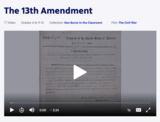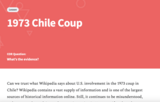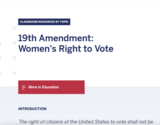
Wall Street Journal interactive that allows students to research and explore 100 ways in which WW1 continues to leave a lasting impact.
- Subject:
- Social Science
- Material Type:
- Interactive
- Provider:
- The Wall Street Journal
- Date Added:
- 11/09/2023

Wall Street Journal interactive that allows students to research and explore 100 ways in which WW1 continues to leave a lasting impact.

Story Map which provides a short overview of WWI, its origins, trench warfare, the armistice, and remembrance, including the creation of Veteran's Day.

By the beginning of 1865, the Confederacy was dying. Abraham Lincoln, with victory within his grasp, looked forward to a second presidential term and a new challenge – healing the nation he had struggled to reunite. In December 1865, the 13th Amendment abolishing slavery was formally ratified.

The 13th Amendment to the United States Constitution, ratified just months after the end of the American Civil War, abolished enslavement and involuntary servitude—except as a punishment for a crime—in the entire United States. As passed by Congress on January 31, 1865, and ratified by the states on December 6, 1865, the full text of the 13th Amendment reads:

This resource from the National Constitution Center includes an introduction, big questions, recorded class sessions, briefing documents, slide decks, and worksheets about the fourteenth amendment of the United States Constitutuion.

The 14th Amendment to the United States Constitution deals with several aspects of U.S. citizenship and the rights of citizens. Ratified on July 9, 1868, during the post-Civil War era, the 14th, along with the 13th and 15th Amendments, are collectively known as the Reconstruction Amendments. Although the 14th Amendment was intended to protect the rights of formerly enslaved people, it has continued to play a major role in constitutional politics to this day.

The Protohistoric period recorded the stories of developing tribal cultures through oral traditions, written accounts, and cultural artifacts. Pawnee ancestors led the return. Some hunted, and left, others remained and contributed to Ponca, Omaha, and Oto tribes. The Oglala and Brule subgroups of the Teton Dakota were horse nomads. This period saw the first contacts between Europeans and Native Americans. Traders from the East Coast arrived, bringing horses and tools as well as whiskey and conflict.

During the sixteenth century, the native peoples of the Plains would encounter Spanish explorers seeking gold and treasure, and later French and British explorers and traders whose technology changed everyday life forever. Desire to control trade and territory in the Central Plains grew, while the colonies that became the beginnings of America were taking hold on the east coast.

The 15th Amendment, ratified on February 3, 1870, extended the right to vote to Black American men seven years after the emancipation proclamation deemed the enslaved population free. Giving Black men voting rights was yet another way for the federal government to recognize them as full American citizens.

The 16th Amendment to the United States Constitution gives Congress the power to collect a federal income tax from all individuals and businesses without sharing or “apportioning” it among the states or basing the collection on the U.S. Census.

Explorers and trappers followed the rivers at first, but Nebraska's waters were not good for all boats. Paths blazed by Native Americans became the basis for overland routes, including the Oregon Trail. Settlers loaded prairie schooners and headed west over the sea of grass across the Platte Valley. Some perished due to illness or accident. Some sought free land, some sought California gold. Mormons blazed their own trail to escape persecution, wintering near Omaha.

The Kansas-Nebraska Act of 1854 created a territory that stretched all the way north from the southern boundary of present-day Nebraska to include all of the remaining lands of the Louisiana Purchase. Over the years, changes were made that left the territory in roughly the same shape and with roughly the same boundaries as Nebraska has today. Its northern and southern borders were drawn along lines based on a system of longitude and latitude developed in the 18th century. Surveyor set markers to physically mark the imaginary lines on the landscape: sections, townships, and acreages were created.

In this activity, students will analyze a historical map showing percentages of enslaved people by county following the 1860 Census. Students will form an understanding of the distribution of slavery in the southern United States prior to the Civil War.

In this lesson, students are introduced to the 1973 coup in Chile and then practice using Wikipedia wisely to investigate information about the role of the United States in the coup. Note: A free educator account is required to access these materials.

This resource from the National Constitution Center includes an introduction, big questions, recorded class sessions, briefing documents, slide decks, and worksheets about the nineteenth amendment of the United States Constitutuion.

Have students bring articles on current events which either support or criticize the 1st Amendment

Students can answer the quiz questions to see how their political beliefs match their political parties and candidates. The survey questions are balanced, and students can learn more about a topic or pick their on response if the ones listed don't match what they think.

Includes dates and information about elections. Includes information related to presidential primaries, voter registration, ballot request due dates, dates ballots must be postmarked by, candidate information packet, vote-by-mail request dates, general elections, dates to register to vote in general election, regular general election, and dates for statewide canvassing.

This lesson plan created by George Washington's Mount Vernon explores primary sources with 20 questions. There are printouts for historical places, prints, objects, and recipes.

The 26th Amendment to the United States Constitution bars the federal government, as well as all state and local governments, from using age as a justification for denying the right to vote to any citizen of the United States who is at least 18 years of age. In addition, the Amendment grants Congress the power to “enforce” that prohibition through “appropriate legislation.”